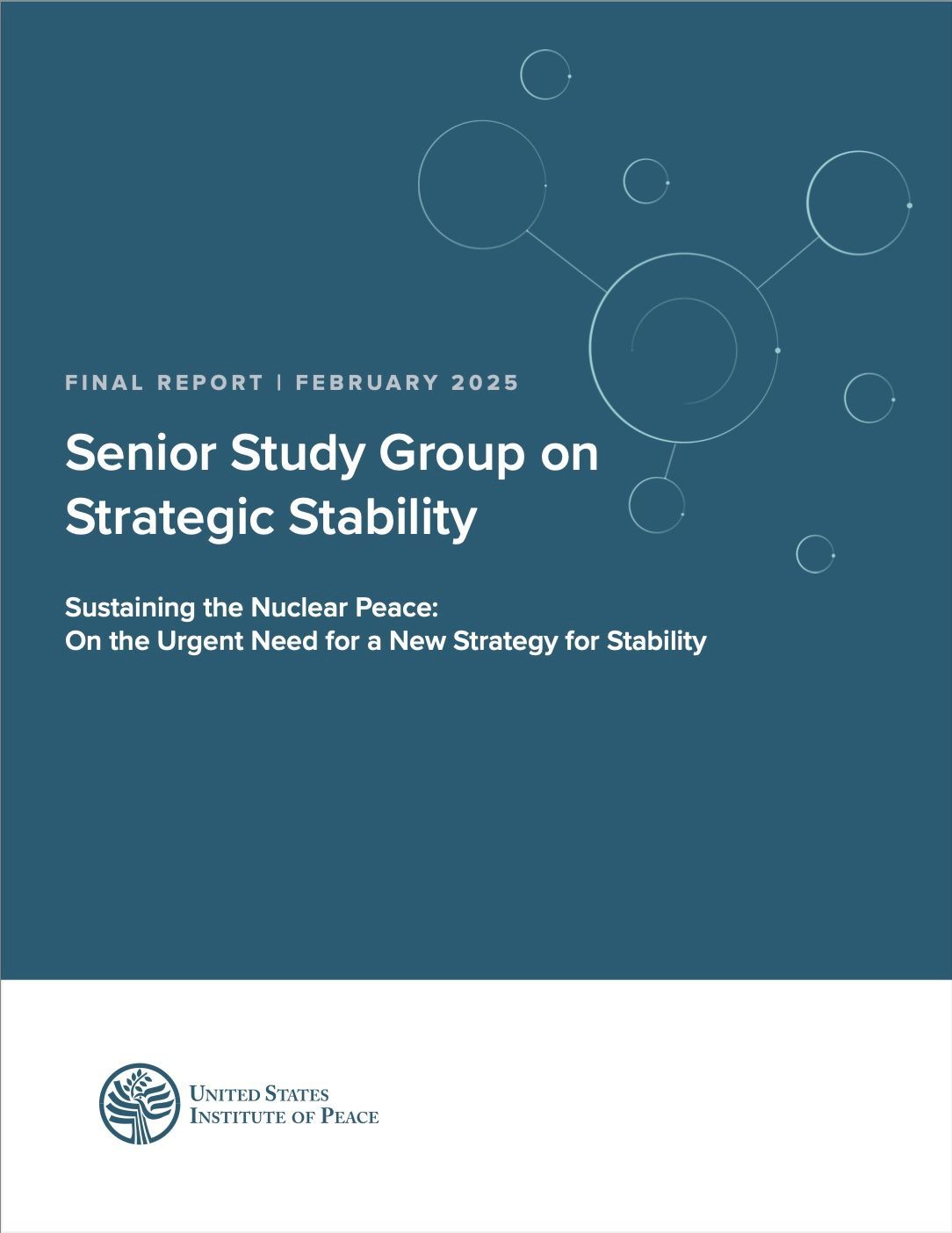Some Thoughts for my British Friends on Nuclear Weapons Policy and Deterrence under the Second Trump Administration
Below is the prepared text upon which Dr. Ford drew in his remarks to and discussions with a nuclear deterrence study group in London on July 28, 2025.
Good day, everyone, and thanks for having me here to London for this important discussion of nuclear weapons strategy, deterrence, and the vital relationship between our two countries. These are just my personal views, of course, and won’t necessarily represent those of anyone else, but hopefully they can help get a good discussion going here today.
The Challenge of Personnel and Process
I should start by noting that so far – in mid-July 2025 – it’s striking now little we know about the Second Trump Administration’s nuclear weapons policy. Part of this is simply because many of the key players who might be expected to develop and implement such a policy aren’t in place yet, though that’s certainly true. At the State Department, for example, there is a nominee for the position whose duties I performed in the last 15 months of the First Trump Administration – that of Under Secretary for Arms Control and International Security – but last time I checked, no one is in place yet. And there aren’t even nominees yet for the position of Assistant Secretary for Arms Control, Deterrence, and Stability, or for my old job of Assistant Secretary for International Security and Nonproliferation.
To be sure, the uppermost politically-appointed positions at the Department of Defense have been filled – the Secretary, the Deputy Secretary, and the Under Secretary for Policy – but there’s still nobody in who might be able or expected to devote more than a fraction of their time to nuclear weapons policy. There is a nominee, for instance, for the Pentagon’s WMD policy role at the Assistant Secretary of Defense level, but he’s not yet in place and has a much stronger background in chemical and biological weapons issues than nuclear ones. The top three relevant positions at the National Nuclear Security Administration (NNSA), which builds and maintains our nuclear weapons stockpile – the NNSA Administrator, the Principal Deputy Administrator, and the Deputy for Defense Programs – also have not yet been confirmed.
Nor does the National Security Council (NSC) seem to be in much of a position to fill the gap. In fact, it’s been largely gutted – cut down to a skeleton-crew staff and explicitly deprived of its traditional interagency policy-coordination role in favor of complete subordination to the Department of State in what appears to be a wholly top-down “just implement what we tell you” role.
Additionally, there is no sign that WMD-related issues are prioritized or appropriately staffed even within the denuded rump NSC that remains. In the First Trump Administration we had a Special Assistant to the President and NSC Senior Director for WMD and Counterproliferation – which was me in 2017! – but there is no such person today. To the extent that these matters are prioritized at all, WMD issues seem to be handled on an “extra duties as assigned” basis between other directorates.
This is a telling point. The NSC often plays a critical role at the outset of a U.S. administration because the White House gets to pick its staff at the NSC from the outset, whereas it usually takes many months before a full bench of senior departmental and agency nominees works its way through the Senate confirmation process. So even if you ultimately want the departments and agencies to take “point” on policy issues instead of the NSC, there aren’t senior political appointees from the new team in place in those organizations to lead things for some time at the start.
For the first portion of any administration, therefore, the NSC is critical to effective policy development on anything that doesn’t rise to the level of a personal priority for the cabinet secretaries and their deputies: in terms of having the President’s own people truly occupying most of the important roles, it’s usually the only game in town for a while.
That was the case, for instance, in the first Trump term. When I was at the NSC chairing Policy Coordination Committees (PCCs) on arms control, nuclear weapons, and other WMD issues in 2017, for instance, for a long time there weren’t any other “politicals” at the Assistant Secretary level around the table at all: just career civil servants who didn’t know when they’d be getting a new political boss, or who that would be. To some extent, from the Administration’s perspective, for a number of months, I was all there was at that level for policy development on WMD issues.
Now, with the Second Trump Administration apparently having decided that it actually doesn’t wish to have a policy coordination process based at the NSC at all – much less people in place with whom to do that – it’s not clear what is happening on nuclear weapons policy issues. It’s certainly ironic for an administration so apparently distrustful of and antipathetic to the career bureaucrats of the so-called “Deep State” to have passed up the opportunity to have presidentially-picked people from the White House complex seize the reins of nuclear weapons policy from the outset, but that’s apparently what has happened.
I am given to understand that there is initial work now underway in departments and agencies to feed into things such as the Nuclear Posture Review and the National Defense Strategy, but at this point such work is necessarily being done disproportionately by the career public servants. I have no reason to doubt their seriousness or integrity, mind you. (In fact, I have every confidence that their work product in these regards will be excellent.) But it is certainly a bit surprising for the Second Trump Administration to have left things to them for so many months!
To be sure, even without a functioning and effective NSC, it might to some degree still be possible to make up for an “early-in-the-term” deficit of senior appointees in the departments and agencies by using lower-level placeholder political appointees on an “acting” basis – something that President Trump has shown himself fond of doing because it avoids the scrutiny and accountability that come with more formal appointments. But even there, such a work-around would only really work if the people being temporarily housed in those “acting” roles had relevant experience and expertise to bring to bear on these complex topics. Nevertheless, there’s little sign of that right now, either.
I hope that all this does not bespeak a de-prioritization of or lack of interest in nuclear weapons policy and deterrence, but there’s scan sign of any prioritization of or focus upon nuclear weapons matters so far.
The Challenge of Policy Direction
Such a lack of focus and clear agenda in this field – other than reassuring but vague platitudes about “peace through strength” – is a striking contrast to the First Trump Administration.
When we came in in 2017 for “T1,” there were some very clear priorities. For example:
- After several years of feckless and ineffectual Obama Administration responses to Russia’s violation of the Intermediate-range Nuclear Forces (INF) Treaty, for instance, we were determined to set that right – either by finally pressuring Russia back into compliance, or by pulling out of INF ourselves. (We emphatically took off the table Obama’s answer of just living with Russian violations while America continued to comply with the Treaty!)
- We were also tired of Moscow’s violations and manipulations of the Open Skies Treaty (OST), and began a process of responsive countermeasures that also ultimately resulted in our withdrawal when Russian abuses did not abate.
- The issue hadn’t surfaced publicly yet, but we also knew about the disturbing new arsenal of “exotic” strategic delivery systems – some of which weren’t covered by the New START agreement – that Vladimir Putin publicly announced in March 2018, and it was clear to us that a new era in nuclear weapons competition was underway.
- When it came to our own U.S. nuclear force posture, the First Trump Administration was also very focused upon starting to remedy the destabilizing gap that previous U.S. administrations had permitted to develop in theater-range systems between our own nuclear forces and the large and growing arsenals of such things deployed by the Russians and Chinese. (That was why, for instance, the 2018 Nuclear Posture Review announced the commencement of the Submarine-Launched Cruise Missile-Nuclear [SLCM-N] program, and why it set in motion the lower-yield W76-2 warhead program as a quickly-implementable stopgap capability.)
Moreover, as part of the “responsive strategy” we set in place vis-à-vis Russian INF violations, we authorized the Department of Defense to begin initial research and development work on potential American INF-class missile systems – though that effort was focused upon precision theater-range delivery of conventional warheads rather than nuclear ones.
All in all, we had a pretty good idea in the First Trump Administration of what we wanted to do right out of the box in 2017, and we were pretty forthright about it.
But it isn’t nearly so clear today where the Second Trump Administration wishes to go. Indeed, the “T2” team has been remarkably quiet about such matters.
Even to the degree that nuclear weapons issues were touched upon in the “Project 2025” policy blueprint published in 2023 by the Heritage Foundation – a long series of policy proposals that despite being ostentatiously disowned by Donald Trump during the campaign seems nonetheless to have been extremely influential in guiding many areas of administration policy in 2025 – we still have relatively little to go by. That document did emphasize the threats presented by China’s huge nuclear buildup [pp. 88 & 93-94], and it urged that China be made the top priority for U.S. defense planning. [p. 93] It also envisioned the United States continuing to rely upon nuclear deterrence to help protect our allies in Europe and East Asia, while urging that the burden of defending Europe in conventional terms be shifted increasingly to our NATO partners. [p. 94] (A similar point was made about defending South Korea. [p. 94])
As for U.S. nuclear weapons themselves, the Project 2025 blueprint stressed that “[t]he United States manifestly needs to modernize, adapt, and expand its nuclear arsenal.” [p. 94] Specifically, it said we need to
- “Expand and modernize the U.S. nuclear force so that it has the size, sophistication, and tailoring to deter Russia and China simultaneously” and
- “Develop a nuclear arsenal with the size, sophistication, and tailoring – including new capabilities at the theater level – to ensure that there is no circumstance in which America is exposed to serious nuclear coercion.” [p.95]
In terms of specifics, the Project 2025 plan called for accelerating the development, production, and deployment timelines for the Sentinel intercontinental ballistic missile (ICBM) slated to replace our ageing Minuteman III, the air-launched Long Range Standoff Weapon (LRSO) for our strategic bombers, the Columbia-class ballistic missile submarine that will replace our Ohio class boats, the new B-21 “Raider” bomber, and Dual Capable Aircraft (DCA) variants of the F-35 “Lightning II” strike fighter. [p.124] (It also called for improving the cyber resilience of our National Nuclear Command and Control [NC3] system. [p.120])
With respect to the U.S. nuclear weapons infrastructure, Project 2025 also recommended we continue to invest in rebuilding that infrastructure, accelerate the effort to restore plutonium pit production capabilities, and restore readiness to test nuclear weapons at the Nevada National Security Site. [p.125] (It did not, however, call for such testing.) It also advocated nuclear warhead life extension programs (LEPs) for the B61-12, W80-4, W87-1, and W88 Alt 370 devices. [p.124]
Unsurprisingly, Project 2025 was also bullish on missile defense (MD), lamenting that MD had been “underprioritized and underfunded in recent years,” whereas it should really have been “a top priority.” In terms of missile defense specifics, Project 2025 urged that we “buy at least 64 of the Next Generation Interceptor (NGI)” systems for our homeland-defense Ground-Based Interceptor (GBI) program, “prioritize procurement of more regional defense systems such as Theater High Altitude Area Defense (THAAD), Standard Missile-3, and Patriot missiles,” [p.126] and improve means for protecting our homeland against cruise missiles. [p.127] The blueprint also called for investing in “future advanced missile defense technologies like directed energy or space-based missile defense,” and for accelerating “the Glide Phase Interceptor, which is intended to counter hypersonic weapons.” [p.127]
All that sounds pretty good to me, I’ll admit, and the nuclear weapons elements of the Project 2025 proposal fit well with many points I myself have made. It is still far from clear, however, how much of the Project 2025 recommendations on U.S. nuclear posture will resurface as Second Trump Administration policy.
After all, the Heritage blueprint also urged that the NSC “take a leading role in directing and thorough review of all formal strategies: the National Security Strategy, the National Defense Strategy, the Nuclear Posture Review, the Missile Defense Strategy, etc.” [p.52] It also emphasized the threats we face from Russia due to its war of aggression against Ukraine. [p. 93] Yet we have now seen the NSC actually be dismantled, as well as what might be charitably described as an ambivalent approach to the Ukraine crisis by the Second Trump Administration. (In another divergence, there is also little sign in the fairly careful Project 2025 recommendations of the extravagant promises of a homeland missile defense “success rate … very close to 100 percent” that President Trump has made for his “Golden Dome” project.) How congruent Project 2025’s agenda for America’s nuclear posture is with actual “T2” policy, therefore, still remains to be seen.
Moreover, even where it did address the future of our nuclear weapons posture, the Project 2025 blueprint hedged quite a bit – never quite taking a position on things that one might think are really important. It did declare that in order to “ensure its ability to deter both Russia and the growing Chinese nuclear threat, the U.S. will need more than the bare minimum of nuclear modernization.” But it didn’t say how much more, or of what.
The Project 2025 document, for instance, urged officials to “consider” procuring “more modernized nuclear systems (such as the Sentinel missile or LRSO) than currently planned,” and that we “[i]mprove the ability of the U.S. to utilize the triad’s upload capacity in case of a crisis.” [p.124] But as to whether we should actually be procuring or uploading more – and how many, and of what – the document remained curiously silent. Similarly, Project 2025 simply urged that U.S. officials “[r]eview what capabilities in addition to the SLCM-N (for example, nonstrategic weapons or new warhead designs) are needed to deter the unique Chinese threat” [p.124], without suggesting what might actually be needed.
In this sense, therefore, Project 2025 didn’t go much beyond the December 2023 report of the Strategic Posture Review Commission (SPRC), which made clear – and on a unanimous, bipartisan basis – that current U.S. modernization program of legacy strategic nuclear delivery systems was necessary but not sufficient, thus signaling that at least some expansion of the U.S. nuclear arsenal was needed. Neither the SPRC nor Project 2025, however, offered any clarity about just what might be needed. And that’s just what all of us are still looking to the Second Trump Administration to decide.
So far, in fact – in its public pronouncements at least - the Second Trump Administration does not itself seem yet to have moved beyond the nuclear weapons policies of the Biden Administration. After all, as evidenced by speeches given last summer by Pranay Vaddi of the NSC staff and Vipin Narang of the Defense Department, even Biden political appointees had come around to making it fairly clear that at least some expansion of U.S. nuclear capabilities would likely be necessary. (No, they couldn’t quite bring themselves to say so, but to my eye they were clearly “softening up” audiences such as the Arms Control Association for the long-overdue bad news!)
I myself am delighted that the traditionally more anti-nuclear Democrats have come around to strategic reason in that way in response to the grim security environment of nuclear threats we face today – a shift that one could see foreshadowed in the fact that the SPRC’s important findings in December 2023 were both bipartisan and unanimous. But if the “T2” Republicans now in power are serious about their strategic stewardship, it’s now time to stop beating around that push and get down to the serious business of figuring out how much more of what it is that we need.
Such clarity may well be coming, in the form of a new Nuclear Posture Review (NPR) at some point. So far, however, no one has signaled any sense of overall direction, few Trump political appointees are in place, and it seem to be primarily only Defense Department and NNSA career civilians who are on the case at the moment. So a lot remains up in the air.
The Challenge of Europe
But from your perspective here in London, I can certainly see that the question merely of what the U.S. nuclear force posture is likely to be is only part of your concern. What is one to make of the “T2” team’s approach to the NATO Alliance and to “extended” deterrence? And what can be done to buttress deterrence in these challenging times?
Let me start by pointing out that despite what one often hears in the press, these are not just problems relating to Second Trump Administration policy. Europe would have some reason for concern about the conventional aspects of the U.S. alliance commitment even were diehard, Europhilic Atlanticists in power in Washington right now – which of course they aren’t.
This is no longer the early post-Cold War period when America enjoyed such relative military might that we could easily and plausibly promise to stand firm against aggression everywhere, all the time. With the growth of Chinese military power and aggressiveness – and Russia’s military revival and resurgent territorial expansionism – it seems increasingly likely that in the event of a conflict somewhere, we’d have to economize on our commitments of critical conventional assets elsewhere. As a result, if there were (for instance) a conflict with China in the Far East, we’d likely have little choice but to surge various types of mobile platform – capabilities, I should think, such as strike aircraft, aerial tankers, ISR assets, logistics platforms, electronic warfare assets, mobile air defense systems, and long-range precision fires platforms – to the Indo-Pacific no matter how committed we were in our hearts to the Atlantic Alliance.
Accordingly, there might quickly develop a serious conventional deterrence deficit in Europe – and a warfighting deficit in the event that deterrence failed, such as in the case of opportunistic aggression by Russia during a Sino-American spat. This gap, I should stress, would thus need to be filled by Europeans in the event of U.S. problems in the Far East even if present-day Washington liked Europe.
Of course, that does not necessarily mean that we would be unable or unwilling to hold up our end of the NATO bargain when it came to the nuclear aspects of deterrence or (God forbid) warfighting. According to the Project 2025 blueprint, at least, the United States should remain committed to the nuclear aspects of extended deterrence even as our allies pick up more and more of the burden of their own conventional defense.
There are still, however, at least some reasons for concern on the “extended” U.S. nuclear deterrence front. The first reason is political, for, frankly, it is not at all clear that the rulers of present-day Washington actually like Europe. Quite the contrary, I’m afraid.
As I’ve noted elsewhere, there are powerful portions of President Trump’s “MAGA” movement that really don’t like Europe much at all – people who look at the world through the prism of our own current poisonous and polarized domestic politics, and who view most of the liberal democracies of Europe as being little more than extensions of Trump’s domestic political opposition in the Democratic Party. This is why, for instance, Vice President J.D. Vance has said that the biggest threat to Europe comes not from terrorist madmen, Russian invaders, fanatical nuclear-armed Iranian clerics, or Chinese neo-imperialists, but rather “the threat from within” presented by Left-leaning politics and social mores. For MAGA folks who believe that – possibly excepting some weird future scenario in which most countries of Europe end up being ruled by Right-wing Viktor Orban, Georgia Meloni, Marine Le Pen, or Alice Weidel types – it’s hard to see why the United States would be particularly interested in the nuclear defense even of a Europe that had somehow managed finally to take its own conventional defense seriously.
To be sure, it’s not a given that President Trump’s personal views would necessarily correlate completely with that ideologically illiberal and resolutely anti-European aspect of MAGA ideology. Trump is, after all, an “instinct” operator rather than an “ideas” guy, and he seems perfectly happy changing his policies dramatically and repeatedly on the basis of what feels like tactical and transactional opportunity, and without obvious concern for conceptual consistency. He also lives in abject terror of ever being taken to be “weak” or “a loser,” and this, too, could affect his approach to nuclear deterrence in Europe. (Is it conceivable that in a crisis, for instance, his obsession with reputational social media optics might prompt him to act the Churchill more than the Chamberlain? One can hope.)
And indeed, Trump already seems to be growing increasingly impatient and frustrated with Vladimir Putin – who with his determination to press forward for a blood-soaked victory in Ukraine, isn’t playing into Trump’s fondly imagined scenario of effortless peacemaking followed by a Nobel Prize – and has already countermanded initial efforts by his appointees in the Pentagon to halt weapons supplies to Kiev. (President Trump’s bold strike on Iran’s nuclear facilities in June was also a very interesting step, and obviously a defeat for neo-isolationists within the MAGA movement.) I am moderately optimistic about “T2” policy in these regards, and certainly more so than I was a few months ago.
Nevertheless, if you’re counting on extended U.S. nuclear deterrence while Trump is in office, you should at least be aware that some parts of his political coalition like and wish to protect Europe no more than they like or would wish to protect Joe Biden or Kamala Harris.
Another reason still to be uneasy about extended U.S. nuclear deterrence in the present context, I fear, is a game-theoretical one that would be familiar to any nuclear strategist from the Cold War. I refer, of course, to the intrinsic challenge of convincing an adversary (and reassuring your allies) that you’d really be willing to risk nuclear attack on your own homeland in order to protect distant friends.
During the Cold War, we developed a number of at least partial answers to this “credibility conundrum.” And indeed, I’d venture to say that U.S. extended nuclear deterrence for Europe did remain reasonably credible during the years in which three things remained the case:
- We had large numbers of U.S. troops deployed in Europe who would be directly in the line of fire in the event of an invasion by Soviet and Warsaw Pact forces;
- U.S. nuclear weapons were also stationed in Europe, both making them subject to attack or being overrun in the event of a Soviet invasion and giving American leaders the capability to mount a nuclear response to aggression on a “rung” of the proverbial “escalation ladder” that still remained below that of a full strategic exchange; and
- We had, under NATO’s “nuclear sharing” construct, forward-deployed U.S. nuclear gravity bombs prepared for delivery in wartime by Dual-Capable Aircraft (DCAs) from partner countries who, in the event of a Soviet invasion, would presumably be less squeamish about starting to nuke Russians than might American leaders sitting in relative safety back home in Washington.
But you can see the problem, of course. Today, the second of those two factors has not been the case for some years in any significant way (relative to Russian deployments, at least), while many in the MAGA movement apparently very much want to take the first factor off the table as well by pulling us entirely out of the conventional defense of NATO.
The third factor of “nuclear sharing” remains in place, I suppose, but with both of those other factors attenuating, one might well wonder whether that will be enough to carry the burden of extended nuclear deterrence alone, without an awkward-to-defend theory of immediate escalation to strategic use. So it’s not hard still to feel somewhat uneasy about this.
So What Might Help?
Given Britain’s strong interest in maintaining close relations with the United States and ensuring the continuation of deterrence in Europe at a time in which Moscow seems aggressive and dangerous in ways unprecedented for a very long time, then, what might be done?
Unfortunately, I can’t claim to have any miraculous answers for you. The collective security commitment articulated by Article V of the NATO Treaty has always been a fundamentally political thing. It is a bond not strictly mandated by any provision of legal text, but that always derived its considerable power and credibility not only from the clarity with which we both viewed our adversaries, but also from the strength, depth, and sheer obviousness of the political, social, cultural, economic, military, and indeed civilizational ties that linked the United States to its alliance partners. Everyone knew we’d probably be there for you, as it were, because it was clear to everyone both that we were, in some loose sense, family, and that this figurative family faced a grave threat.
In that sense, broad trends and dynamics in that international connective tissue may be more important, at the end of the day, than the details of anyone’s actual nuclear force posture, doctrine, or declaratory policy. (Such connective tissue, moreover, is much more easily damaged than it is rewoven.) This makes the seeming ephemera of “politics” and “culture” hugely important in what most people assume is the very concrete business of deterring aggression, and makes current trans-Atlantic “culture war” frictions doubly worrying.
That being said, there are perhaps some things that could still help bolster deterrence in Europe, both in the conventional and in the nuclear weapons arenas.
Improved U.S. Capabilities
In terms of unilateral U.S. capabilities, I believe we need more theater-range systems to be arrayed against the destabilizing overmatch of Russian capabilities we currently face. (And, yes, this is absolutely true in the Far East as well.) That’s why, for instance, it was so discreditable for the Biden Administration to have tried to cancel the SLCM-N program, thereby ensuring its delay even though Congress sensibly stepped in to countermand that unwise decision.
Beyond just the sea-based SLCM-N, however, I think it might help to have U.S. nuclear systems deployed in Europe once again. That is something, after all, that certainly helped force the Kremlin into much more reasonable arms control negotiating positions the last time we took such a step with the famous “Euromissile” deployment in 1983. Nevertheless, I’m not sure that even with today’s bellyful of Putin provocations, the Europeans are really ready for that, nor do we yet have any such deployable system in hand and ready for the job.
Arguably even better and more flexible than such a “bespoke” Euromissile-style nuclear delivery system, however, might be some kind of small nuclear warhead package capable of being fitted into one or more (or several?) existing or planned long-range precision strike systems on a swap-in/swap-out (SI/SO) basis, thus allowing those systems to be optionally converted to nuclear delivery. This would allow us to leverage existing or already-planned precision delivery programs for the benefit of nuclear deterrence, too; it would also greatly increase the range of possibilities available for “nuclear sharing” within the NATO Alliance.
Enhanced NATO “Nuclear Sharing”
And speaking of NATO “nuclear sharing,” I’d love to see us work together to “upscale” the system a bit. That would mean more U.S. bombs in more vaults, and in more countries – including in (or at least involving DCA assets and trained-up pilots from) partner countries further East.
Indeed, in addition to having some additional weapons in play, I’d also like there to be a lot more vaults than needed to store those weapons – as well as a cycle of relatively frequent logistics movements between them, involving both real weapons and “dummy” units. (I am also intrigued by the new mobile, containerized, semi-clandestine vaults now being developed by the Sandia National Laboratory, which are apparently, and surely not by coincidence, perfectly sized for the B61-series gravity bombs that form the basis of the NATO “nuclear sharing” program.) This would confront the Russians with a “shell game” that would reduce their ability to develop a high-probability theory of victory, greatly problematize the Kremlin’s targeting in wartime, and increase Allied options in a crisis – to include sending additional weapons to Europe to fill up more of those vaults, either surreptitiously or openly, as a strategic signal.
Even when DCA variants of the F-35 come online in Europe, however – and kudos to His Majesty’s Government, by the way, for recently deciding to buy some – I’m still not sure it’s a terrific idea actually to fly your plane right over a really well-defended target. For that reason, if “nuclear sharing” with aviation assets is to have a solid future, I would think we need to give DCAs some kind of stand-off delivery capability. I’m not sure that any existing air-launched missile systems carrying a nuclear weapon can fit inside an F-35, so this could perhaps be a bit tricky – but that small “SI/SO” nuclear warhead package idea I mentioned earlier might come in rather handy.
I admit, however, that even the NATO “nuclear sharing” construct is still dependent upon America’s willingness to at least support allied nuclear strikes against invading Russian forces or other Russian targets by granting permission for U.S. weapons to be employed. Accordingly, in an era when worrying questions have been raised about U.S. alliance commitments, this means that Europe’s own nuclear and conventional capabilities will be more important than ever. So let’s talk about your capabilities over here on this side of the Atlantic.
European Conventional Defense
With respect to non-nuclear arms, it should go without saying that Europe finally getting truly serious about its conventional defenses would help the credibility of extended U.S. nuclear deterrence, for it would decrease Europe’s degree of relative need for deterrence that draws upon capabilities beyond what conventional arms can provide.
To be sure, a Europe that was able to defend itself against Russian threats “perfectly” without any U.S. assistance would obviate the need for American extended deterrence at all, of course. Nevertheless, there’s no chance of that in the foreseeable future, and the primary danger today lies in NATO being able to do so little on its own that an exasperated and increasingly disinterested Washington concludes that you simply lack seriousness and don’t want to be secure enough to make it worth the American cost, effort, and risk of defending you.
I’m encouraged by the recent Hague Summit Declaration, which commits most of America’s NATO allies in Europe – with the rather shameful exception of Spain, which appears to revel in being a national security free rider – to meeting a defense spending target of 3.5 percent of Gross Domestic Product (GDP) by 2035, coupled with an additional 1.5 percent for a variety of nominally defense-related expenditures. If this new target is really taken seriously and our allies manage to forego embarrassing gamesmanship in sliding lots of random and unjustifiable things into the loose category of that 1.5 percent in “defense-related” spending, this should help a great deal.
Most importantly, augmented spending should actually help improve European defense capabilities. I hope our allies will have the good sense to coordinate their approaches along lines of mutually-supportive and deeply interoperable comparative advantage, rather than just building cookie-cutter forces that will end up being collectively inadequate, hamstrung by being unable to provide the right assets, in the right numbers, in the right place, and at the right time in the operational and logistical complexities of a real European fight. If they do, however – and perhaps recent steps like the recent UK-German Kensington Treaty will mark a start of new efforts – the new NATO spending targets are very promising.
To put it frankly, moreover, the new spending targets also help President Trump with one of his most important objectives: doing things that he can portray in social media as him “winning” at something. Policymaking in Washington these days is only partly about policy outcomes, for assessing those can be complicated and time-consuming, and in any event takes expertise, expertise, and careful evaluation.
Instead, a key focus of policymaking seems now to be the creation of ideological performance art. That is, it is about making claims and issuing pronouncements that achieve memetic virality in the social media attention economy – dominating the discourse, thrilling one’s political base, rattling one’s political opponents, and conveying at least the momentary impression that one is doing bold and important things – before everybody moves on to paying attention to something else. (What actually happens later, in terms of policy outcomes, often seems to be of merely secondary or tertiary importance. Dealing with eventual outcomes is at most a problem for another day’s attention economy, or better yet something for someone else to worry about entirely.)
In this context of policy-performative theatricality – and admitting that the real-world actions of Vladimir Putin surely have even more to do with NATO’s boost in defense spending than does the rhetoric of Donald Trump and his team – it is very important that our president can now say he pushed Europe into finally taking its own defense seriously. There is real truth in this, and this narrative reduces the odds of American backsliding on its alliance commitments, giving Trump a stake in preserving the metric of the ”win” by not undermining or sabotaging “his” own NATO spending bump by cutting back American involvement before that spending starts to produce results.
That said, of course, this naturally means NATO allies actually have to follow through on the pledge. U.S. presidents of all political stripes have been urging NATO to spend more for the last quarter century, and the former NATO defense spending target of two percent GDP goes all the way back to an oral pledge made in connection with the Riga Summit in 2006. NATO more formally ratified that target in 2014 at the Wales Summit, just after Russia’s first invasion of Ukraine. Yet by 2021 – just before Putin’s second, now full-scale invasion – only six countries had met that target. Even last year, ten years after Wales and nearly two decades after Riga, nine countries of the alliance remained short of two percent. That’s a pretty poor track record, to say the least. A great deal rides on NATO being able to do much better now with its new target.
If NATO defense investments do pan out, however, that will be very good news both for European defense and for the U.S. alliance relationship.
Maybe I’m being too optimistic, but it’s not entirely beyond imagining that the alliance could eventually end up stronger than it has been in a long time.
A Europe better able to defend itself – especially in circumstances in which all those “low-density, high demand” American assets in Europe might suddenly have to be moved to the Indo-Pacific – might also be a Europe capable of playing a much more Trump-congenial role in a true two-way partnership with the United States. Indeed, if for some reason the threat of opportunistic Russian aggression in Europe were not too great – such as if Moscow remained bloodily bogged down in Ukraine or otherwise preoccupied – one might even imagine that some European assets of this sort could perhaps be deployed to the Indo-Pacific to help us somewhat with our highest security priority in a crisis.
Surely that would surely be an attractive alliance from Washington’s perspective! Under Secretary of Defense Bridge Colby has reportedly said, rather inexplicably, that “we don’t want you” to help us in the Indo-Pacific, but his bosses would surely have a different view if things got really dicey out there. In the event of crisis, help from our friends would surely be welcome in what Washington now considers the most important theater.
NATO Nuclear Weapons
With regard to NATO nuclear weapons, I’m not persuaded it’s time to condone “friendly” proliferation to a country that is not today already a nuclear weapons possessor. I’m realistic enough to acknowledge that given trends in today’s increasingly problematic multipolar environment, I cannot rule out future circumstances of worsening Russian and Chinese threats and growing American isolationism in which I might be won around to such an argument. But that is not today.
The Second Trump Administration has not yet proved quite as isolationist as it initially seemed to signal – and as our allies feared and our adversaries hoped – and it’s premature to declare the demise of U.S. extended deterrence, especially if NATO allies continue to show Washington that they are committed to being resolute defense partners and these efforts are bolstered by a more robust Anglo-French approach to nuclear deterrence.
On the issue of Europe’s indigenous nuclear deterrent, the recent Anglo-French Northwood Declaration proclaiming a joint commitment to responding to extreme threats to Europe and deepening nuclear weapons-related cooperation and coordination – for instance, through the establishment a UK-France Nuclear Steering Group – strikes me as a good sign. Nevertheless, given Russia’s willingness to use nuclear threats in coercive bargaining and its huge advantage in theater-range nuclear forces, Europe’s current indigenous arsenals still don’t seem large or flexible enough to be particularly effective from an escalation-management perspective.
To be sure, the French have commendably retained an air-launched missile that would indeed seem to represent a rung of the escalation ladder below firing salvoes of Submarine-Launched Ballistic missiles (SLBMs). But Britain and France could still use additional national nuclear capabilities of more intermediate range and flexibility. I don’t know what the odds are of London and Paris actually cooperating on such a program, but whether they act jointly or severally, it is time for those countries to get back in the business of increasing the size of their arsenals – not necessarily by a lot, but in ways that help fill dangerous gaps and provide more deterrent flexibility.
As for what the best ways might be to do this, it’s not at all clear to me what the “realm of the possible” is in British and French nuclear weaponeering from the perspective of technical feasibility and infrastructure capacity, nor what might be politically imaginable for them in terms of direct cooperation. I know nuclear weapons issues have more domestic political salience and sensitivity over here than they do back in America.
Nevertheless, in the interest of stirring the intellectual pot in order to stimulate discussion here in this study group, at least, let me offer some imaginative and perhaps provocative speculations to get our discussions going.
- First of all, if the stand-off range were good enough – as it likely would indeed be for the French ASN4G scramjet-powered hypersonic system currently under development – a new capability for non-stealthy external carry of an air-breathing nuclear standoff system on F-35 DCAs might be an effective way to add to a collective nuclear deterrent. Another might be to put some American SLCM-N missiles in the Vertical Launch System (VLS) batteries of British nuclear-powered attack submarines – though this might perhaps require they be fitted with British warheads, which could be challenging for the Atomic Weapons Establishment (AWE) at Aldermaston. (That’s a question for another day’s lawyering.)
- Second – and even farther “outside the box,” perhaps – I find myself wondering what the United States will do with its current fleet of 1993-vintage B-2 “Spirit” strategic bombers once the new B-21 “Raider” comes online.
I suppose my first preference – and a step arguably more consistent with an “America First” defense policy, it must be said – would be for Uncle Sam simply to undertake life-extension programs for those big stealthy birds in order to keep them in service longer, not unlike what we’ve done with our truly ancient B-52s since they transitioned into stand-off nuclear delivery service. (The Spirits would also remain handy in other ways, not least because they can carry a huge conventional bomb load, and because I’m still not entirely sure the smaller B-21s can carry our enormous GBU-57 “bunker buster” munitions.)
If the United States didn’t want to keep all of the old B-2s, however – and current U.S. assumptions are that we will not keep them in service – perhaps we might consider selling them to Britain, the nuclear-armed NATO ally with whom we have had an enormously close and cooperative nuclear deterrence relationship since 1958. (Another scholar of these issues has alternatively urged that we give our old B-2s to Australia, though presumably not for nuclear uses. That’s not a bad idea either, but in both cases I fear our allies would struggle with the cost and effort of maintaining those finicky aircraft.) In British service, I assume the Spirits would have no physical trouble carrying large – French? – standoff missiles for nuclear delivery, and they could likely still overfly some targets directly to drop nuclear gravity bombs.
Conclusion
Anyway, it’s time for me to stop speculating – and time for us to begin what I am sure will be some really interesting discussions. I hope that I’ve been able to provide some useful perspectives and some interesting, and perhaps provocative, “food for thought” to get things going here.
Thank you for having me back to London, and thanks for listening.
— Christopher Ford







